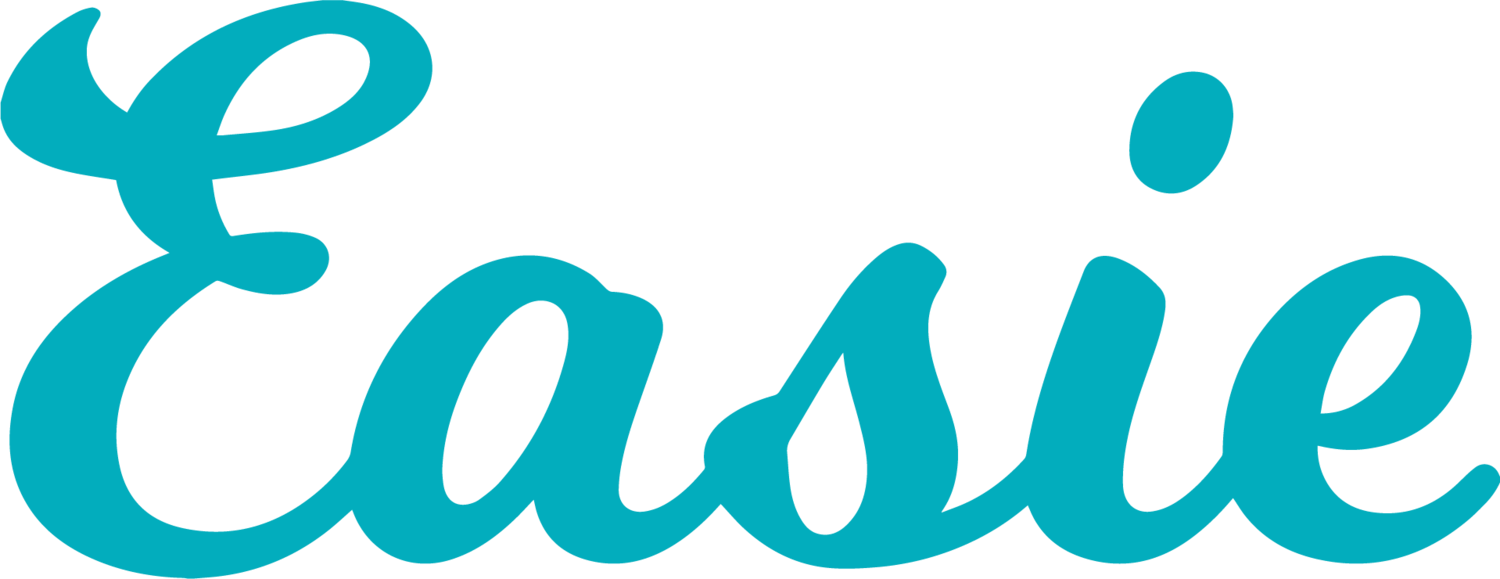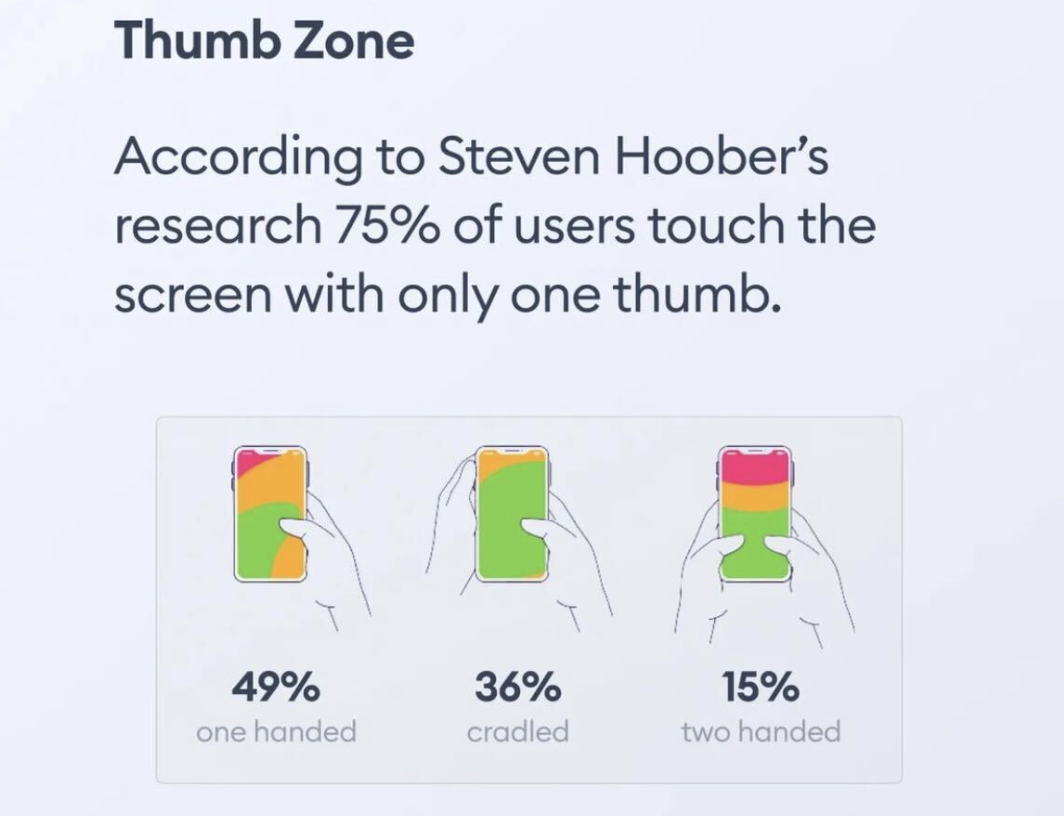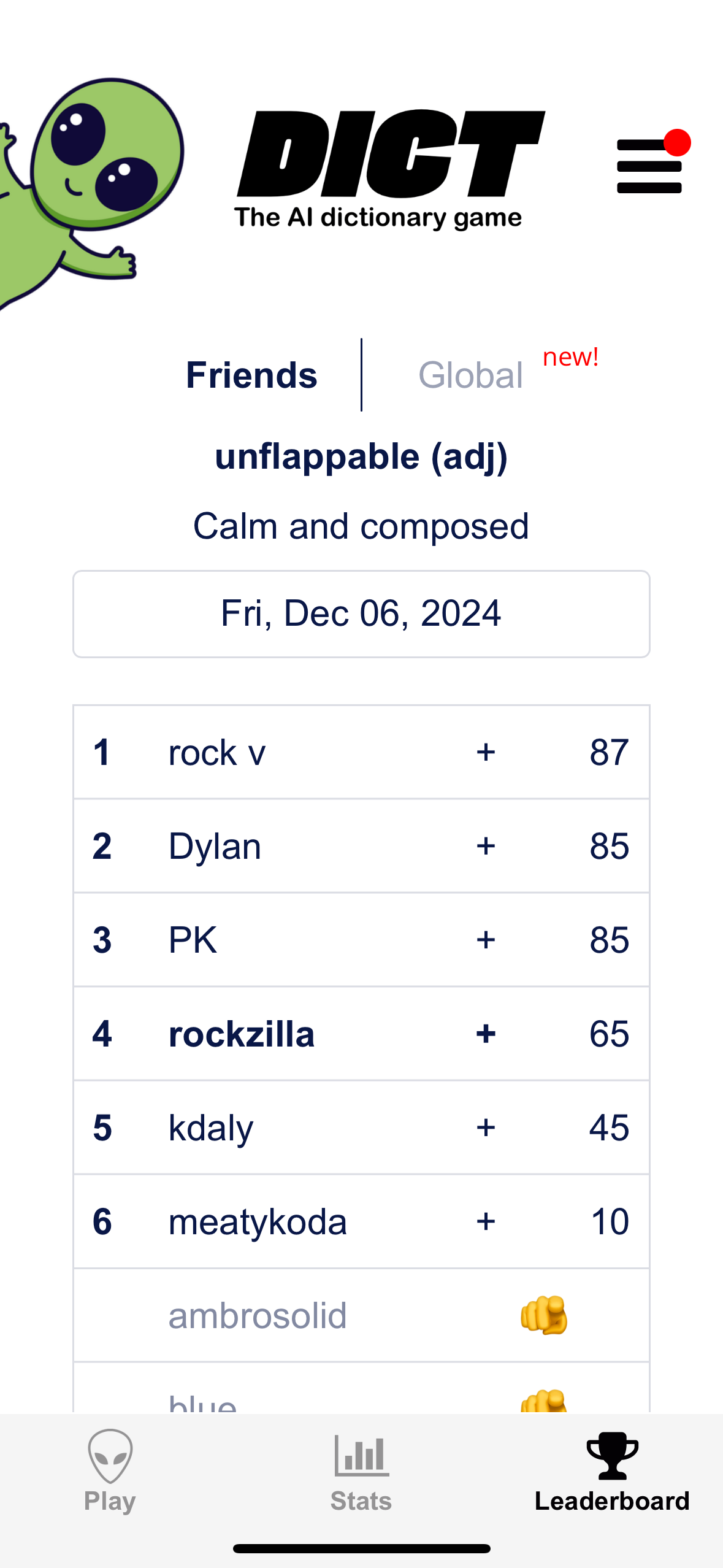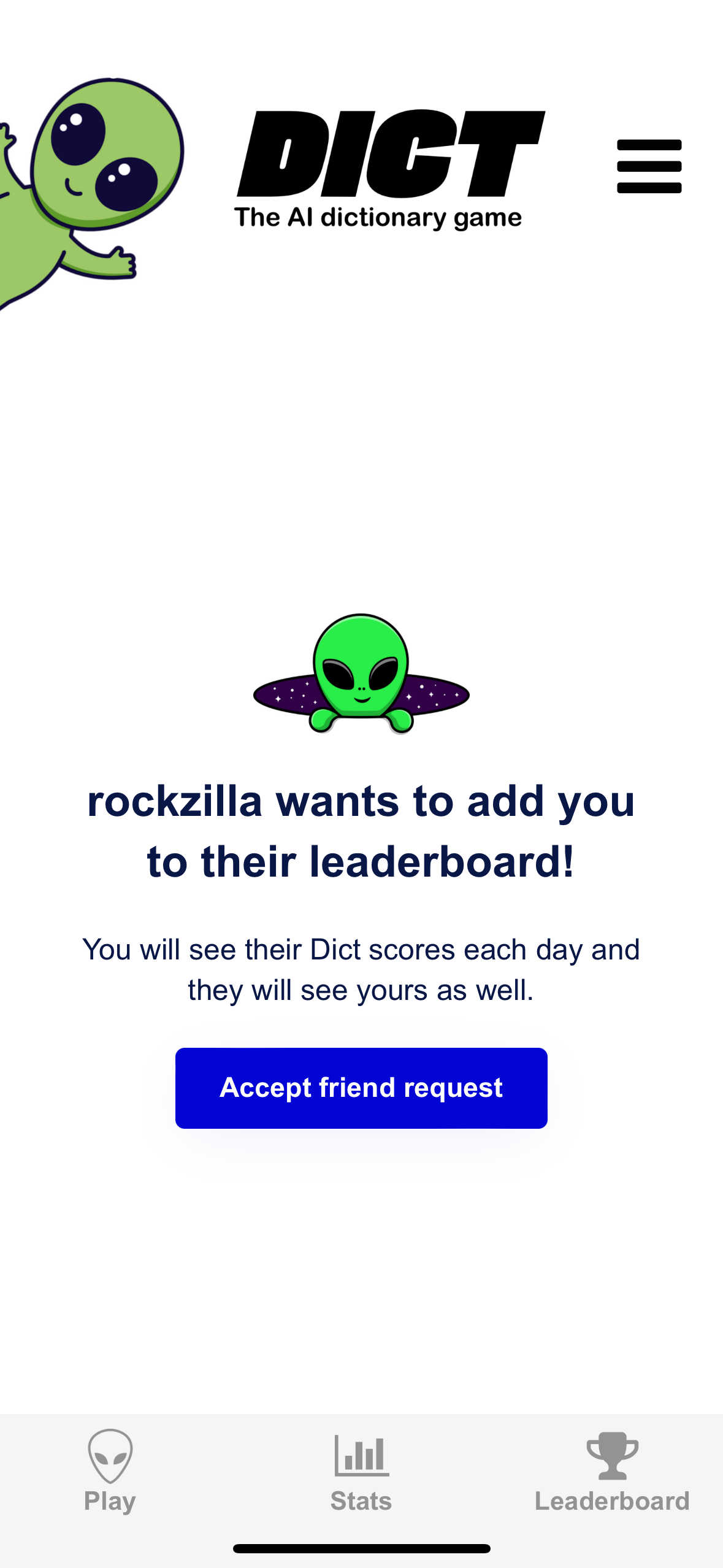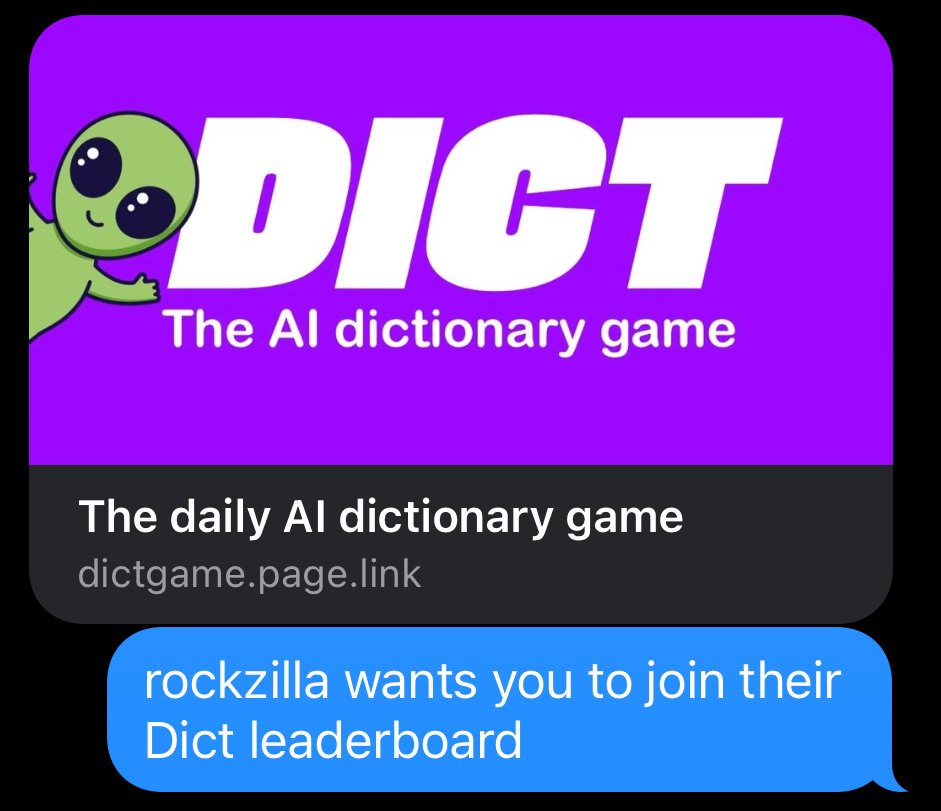Easie develops version 2 of "Dict" - an AI dictionary game - on iOS and Android app stores
In 2023, Easie was engaged to create an MVP (minimum viable product) for “Dict,” a learning game focused on expanding your vocabulary using AI. Each day a player gets a new word to define and AI judges how close it is to the dictionary definition. The game gets even more fun when users invite friends and see how their scores stack up against friends in the leaderboard. Version 1 of the application was built exclusively as a web application with mobile-friendly optimization.
After initial user growth and iterative product feedback, Easie’s engineering team was engaged again by this client to develop version 2 of Dict with the goal to release it as an actual mobile app on the iOS and Android app stores. With Easie’s background in software engineering and product design, we rapidly developed Dict version 2 with successful release on mobile app stores over a six-month period with 0% downtime for Dict version 1 during the process.
Today, Dict version 2 has over 150 mobile users, 50 daily active users and continues to grow. This article explores the key features of Dict version 2, the process of developing the app and key considerations from an engineering standpoint.
1. Structuring the information architecture
For Dict version 2, structuring the information architecture was a critical task to optimize the user interface for mobile phones. Our team implemented a mobile-friendly design, footer-based navigation and an interface that optimized for the “thumb zone” (1).
The redesign process was heavily informed by existing user feedback prior to development; user-based acceptance testing was a critical component of this process.
Version 2 consists primarily of three simple screens for:
The gameplay screen: the area where users can play the game and submit guesses to words each day. As a contrast to Dict version 1, we implemented functionality for a single word each day compared to Dict version 1 where users were asked to guess three words each day.
The stats screen: this section allows users to see their weekly score and statistics on a bar chart with a simple date picker to view score progression over time.
The leaderboard screen: users being able to see the scores of their friends on a leaderboard was one of the most popular features of Dict version 1. We also launched a global leaderboard showing the top three users each day after this feature was requested frequently post-launch of version 2.
The UI/UX updates of Dict version 2 were critical and included other screens for account management, settings, notifications and a contact us form for user feedback.
2. Implementing secure user authentication
Recognizing the critical importance of data security in digital applications, a robust login and user authentication system was implemented. This feature not only protects against unauthorized access but also enables a personalized user experience by tracking individual game progress and preferences. Controls were put in place to ensure usernames could be used more than once by new users.
3. React Native codebase & availability on iOS/Android app stores
A critical requirement for achieving mobile functionality was acceptance from Apple and Google on the iOS and Android app stores, respectively.
The app was built using React Native which is a Javascript-based framework for building frontend interfaces. React Native is unique in the sense that it allows for a single codebase to be used for both iOS and Android. React Native offers a significant advantage for both maintainability and adding new features as historically engineering teams would use two separate native codebases to support both operating systems.
In addition to development of the codebase, Easie also successfully submitted the app to both app stores which were approved by the Apple App Store and Google Play Store.
It is worth noting that the process for submitting to iOS is significantly easier than submitting to Android, as Google requires a closed testing period involving at least 20 separate testers in order to approve the app for production and submission to the Google Play store. This requirement, often seen as cumbersome to businesses and smaller developers, represents an obstacle and can delay rollout; despite this, Easie was able to mobilize a team of 20 testers and successfully complete this requirement prior to approval by Google to production.
4. Integrating AI with OpenAI's GPT-4o API & optimizing the game ”judge”
Like Dict version 1, the application was integrated with the ChatGPT completions API from OpenAI. This machine learning-powered API generates human-like text based on user input, thereby creating responsive scoring and challenges within the game.
In contrast to version 1, we did deeper research and testing to optimize the scoring algorithm to provide scoring not just based on lexical similarity (how literally close the words are to the definition) but also semantic similarity (how close the guess is in meaning and understanding even if different words are used). This optimization around semantic similarity was one of the key improvements to scoring and was based on feedback received from players in version 1.
5. Incorporating push notifications & social interaction features
To increase user engagement, Easie implemented “social-lite” features consistent with the most popular mobile apps. Users receive push notifications related to key events like a new word being available, a friend request being accepted or a friend reacting to a player’s guess.
Giving users the ability to react to a guess with an emoji increased engagement and added a level of cheekiness and fun to the game that otherwise may have been a more inert or passive user experience.
Additionally, users are allowed to send a single “nudge” to their friends each day if they have not played yet, further increasing engagement and adding lightheartedness to the user experience without being annoying, impersonal or invasive.
6. Adding complexity to the database schema
The database powering both Dict version 1 and version 2 is a relational SQL database built on Postgres and AWS RDS. The schema required updates after version 1 to include sections for deeper friend engagement, notifications, user statistics and behavioral analytics. These updates were done in a separate development environment prior to pushing the new features to production in the live environment after the app was ready to ship.
7. Boosting engagement with shareability features & deeplinking
Dict version 1 included the integration of an "invite friends" feature. This functionality enabled users to share their game results and invite friends to the game with a link to the web-based app (i.e. a normal URL). Being able to share an invite link to friends directly from the app is a critical requirement for social-based mobile apps.
For version 2, this went a step further: the share popup in a mobile app is commonly referred to as a share sheet; this link, known as a deeplink, directs users to the appropriate app store (iOS or Android) if the app is not installed. If the app is already installed, the deeplink automatically opens the app.
Installing deeplink functionality was critical to maximize user signups, avoid frustration and minimize clicks during the signup process. Further, users clicking the deeplink invite from a friend see a friend request screen automatically after downloading or opening the app.
Conclusion
The development of Dict version 2 is a case study demonstrating Easie’s software engineering expertise using advanced technology and user-centric design principles for rapid product deployment for a repeat client after a previous successful project. This project also shows the potential of AI in many areas of society including business, recreation and automation of processing unstructured data. The possibilities for technologies used in this project are truly vast.
Want Easie to help build your next AI product or mobile app? Get in touch with our team to learn more about how we can help.
